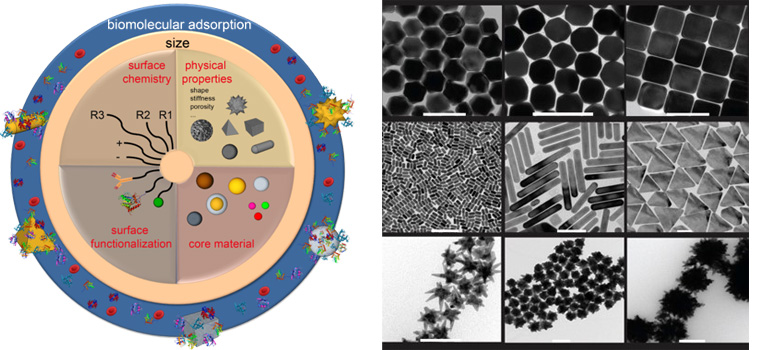How do physical and chemical features of nanoparticles contribute to their activity?
To understand the role of distinct physical and chemical features of nanoparticles in their capacity to function, we have established a fully controlled process for the endotoxin-free synthesis of nanoparticles with a variety of sizes, core materials, shapes and surface functionalisation. The workflow involves in-depth characterisation of nanoparticles for a variety of features such as size distribution, shape, surface charge, surface ligand density, optical properties as well as cellular localisation.
This way we design particles with well-defined characteristics to address a variety of research questions and towards targeted applications.

On the left, the potential variety of nanoparticle types in terms of the combination of size, core material, shape and other physical properties, surface chemistry and functionalisation are illustrated.On the right, Transmission Electron Microscopy (TEM) micrographs of Nanoparticle Shape Library developed at CBNI are shown - From the top left: gold nanotrisoctahedra, faceted gold nanorods (top view), gold nanocubes, gold nanorods, gold nanoprisms, gold nanostars and gold urchin-like. To facilitate nanoparticle studies in a range of experimental conditions, we also develop novel approaches to disperse nanoparticles and provide colloidal stability under relevant biological exposure conditions using biocompatible agents. (Castagnola et al., Nanoscale Horizons, 2017)
Selected publications:
Castagnola, V., et al. "Towards a classification strategy for complex nanostructures." Nanoscale Horizons (2017)
Talamini, Laura, et al. "Influence of size and shape on the anatomical distribution of endotoxin-free gold nanoparticles." ACS Nano (2017)
Hristov, Delyan R., et al. "Tuning of nanoparticle biological functionality through controlled surface chemistry and characterisation at the bioconjugated nanoparticle surface." Scientific reports 5 (2015)
CBNI grouping investigating BioNano Interactions
School of Chemistry and School of Biomolecular and Biomedical Science, University College Dublin (UCD), Belfield, Dublin 4, D04 N2E5, Ireland. T: +353 1 716 2293 | E: info@cbni.eu | Location Map(opens in a new window)Monday - Friday | 09.00-17.30 Ireland and UK | 10.30-18.30 CET | 00.30-08.30 PST | 17.00-01.30 Japan | 01.00-09.30 PDT